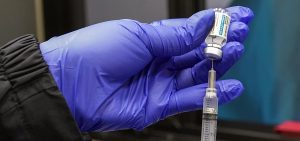News
Study Finds Vax-A-Million Not Effective In Getting Ohioans Vaccinated
By: Anna Huntsman | ideastream
Posted on:
CLEVLAND (ideastream) — The DeWine administration and national researchers are at odds as to whether the state’s Vax-A-Million lottery sweepstakes made a significant impact on vaccination uptake.

“That bump was essentially mirrored nearly exactly by a small bump everywhere,” said lead researcher Dr. Allan Walkey. “It was hard to attribute the changes observed and reported to the lottery itself, and it appeared that the lottery didn’t have a large effect on increasing vaccinated people.”
The Boston University researchers did not use ODH’s data in their analysis. Instead, they looked at national adult vaccination trends reported by the U.S. Centers for Disease Control and Prevention (CDC) from the four weeks before and after the Vax-A-Million announcement, and compared Ohio’s rate to other states, Walkey said.
Ohio’s increase might instead be attributed to other factors, he added. Two days before Ohio lottery was announced, the U.S. Food and Drug Administration expanded vaccine eligibility to children aged 12 to 15, which could have spurred an uptick in adult vaccination rates as well, Walkey said.
Dan Tierney, spokesperson for Gov. Mike DeWine, said this reasoning is “flawed.” Data analyzed by the Ohio Department of Health (ODH) shows vaccinations increased in every age group after the lottery was announced – not just 12- to 15-year-olds, he said.
“We believe that’s solely due to the Vax-A-Million,” Tierney said.
ODH data shows vaccinations increased 44 percent the first week after the lottery was announced and 15 percent the following week in individuals 16 and over, Tierney said.
Walkey said following the lottery announcement in mid-May, Ohio’s vaccinations increased at a rate of 30 per 100,000 people, compared to 27 per 100,000 nationally.
“Our results do not say that there was no effect of the lottery, it’s just that it seems like there wasn’t a big effect. The bumps were pretty similar in the U.S. and Ohio around that time,” Walkey said.
But Tierney maintains Vax-A-Million deserves credit for Ohio’s increase.
Anecdotally, he has heard from health departments and Ohio residents that many people chose to get the vaccine sooner to try to win the lottery or scholarship.
“It’s pretty clear that the only really unique variable between what happened in the other 49 states and the district of Columbia and the other territories is Vax-A-Million,” Tierney said.
One of the lottery winners, Jonathan Carlyle of Toledo, told DeWine in a press conference he decided to get the vaccine sooner after hearing about the lottery. And scholarship winner Sydney Daum’s mother, Jennifer, said she was waiting until later in the summer to get her daughter vaccinated, but Vax-A-Million motivated her to sign up sooner.
While the newly eligible 12-to-15 age group saw the biggest increase after Vax-A-Million was announced, the next biggest increase was reported in 16- and 17-year-olds, according to ODH data. Walkey said that might also be attributed to the FDA’s expansion of vaccine eligibility that week.
“Older kids might have gotten vaccinated with their younger siblings, as well as, the parents may have gotten vaccinated at the same time while they were there,” he said.
Plus, adults may have had more confidence in the vaccine after the eligibility was expanded to younger ages, he added.
Tierney heard from Ohio high school and college students that they had been waiting until after the school year was over to get the shot, but Vax-A-Million encouraged them to get vaccinated sooner.
The only way to know for certain whether Vax-A-Million directly encouraged a significant number of people to get vaccinated, both Tierney and Walkey said, would be through one-on-one interviews.
Walkey said that based on national data, it does not appear that million-dollar lotteries are an effective vaccination strategy going forward.
“People who are vaccine hesitant are not going to be swayed by a small incentive, or maybe even a big incentive, because I think the reasons a lot of people are not getting vaccinated are strong beliefs,” he said. “I think it’s mostly going to be engagement and discourse at this point as the way to move forward with the remaining unvaccinated.”
Tierney said smaller-scale vaccination incentives will be announced in Ohio in the coming weeks.
Currently, 47 percent of Ohioans have received at least one dose of the COVID-19 vaccines – lagging behind the national average of 57 percent.

